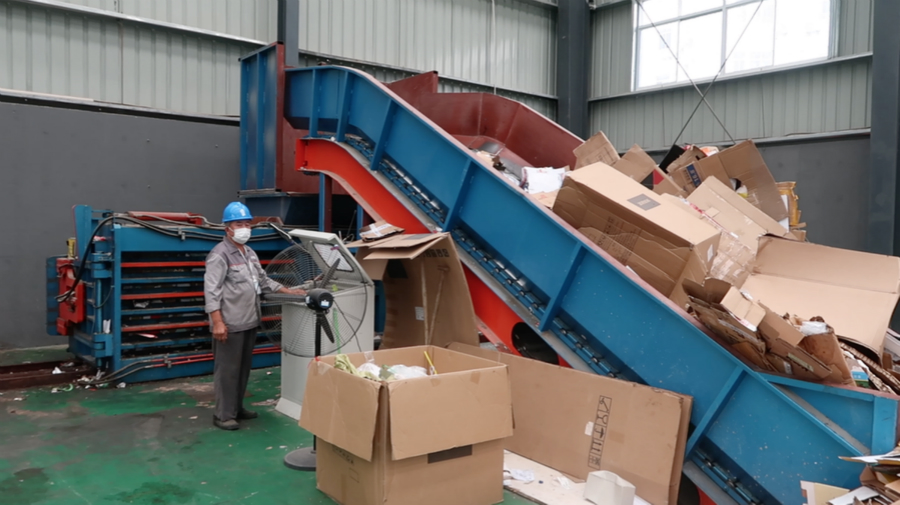Waste management booming

A worker operates machines to compress plastic foam and carton boards in Pujin Recyclable Transfer Center in Shanghai. [Photo by Xing Yi/chinadaily.com.cn]
Industry now worth billions of dollars as country tackles mounting problem
In Shanghai's Pujin subdistrict, sculptures made from beverage cans, bicycle tires and plastic bottles are displayed around a recyclable transfer center. This is where 17 trucks transport recyclables every week from 71 districts and nine villages near the center.
"We came up with the idea of making sculptures with trash to let people know that trash can be useful when sorted properly," said Ma Jun, deputy manager of the center.
Residents can use a WeChat mini app to request that their recyclables are picked up, or they can deposit the recyclables at a designated station in their neighborhood. After the recyclables are compressed, they are sold to big recycling plants to be turned into raw materials again.
The Pujin facility, built in 2019, is one of the 200 recyclable transfer centers operating in Shanghai. They collect about 6,800 metric tons of discarded glass, textiles, plastics, paper and metals every day. It is also part of the growing waste management business that China has been building in recent years.
Solid waste management has become big business in China as the country resolves to tackle the mounting urban trash problem in the next five years. This has in turn created multibillion-dollar market opportunities in the industry.
China is among the world's largest producers of municipal solid waste, which is generated from companies, institutions, individuals and households. According to the National Bureau of Statistics, the country's urban population produced 240 million tons of waste in 2019.
The solid waste management chain includes trash collection, transportation, treatment and recycling. Currently, more than 99 percent of urban waste is collected and around half of it will go to incinerators, while the rest ends up in landfills, which has created problems of soil and underground water contamination and land shortages.
Experts said the way out of the urban trash problem is to increase the percentage of trash incineration and recycling, and that sorting trash at the disposal stage is key to recycling.
"Trash sorting can drive the upgrade of the whole waste management chain," said Liu Jianguo, a professor at Tsinghua University's School of Environment. "When domestic trash is separated, kitchen waste can be processed with compost technology, and much of the resources can be recycled without being mixed with wet waste."
The country launched pilot trash classification programs in the early 2000s, only to receive a lukewarm response from the public. It was only in 2018, when President Xi Jinping emphasized the importance of trash classification, that the initiative started to get on the fast track.
In the proposal for the 14th Five-Year Plan (2021-25) and the long-range objectives through the year 2035, now ratified, the Communist Party of China Central Committee said the country should implement trash classification, reduction and resource recovery, and accelerate the building of waste recycling systems.
The question "What kind of trash are you (carrying)?" became a popular joke among people in Shanghai when the city implemented a law in 2019 that required the sorting of household waste into four categories-recyclables, kitchen, hazardous and residual waste (nonhazardous waste material that cannot be re-used or recycled)-or face fines.
Community volunteers and grassroots officials stationed at the trash bins would ask people who came to dump trash that question and helped them gain knowledge of trash classification.
























